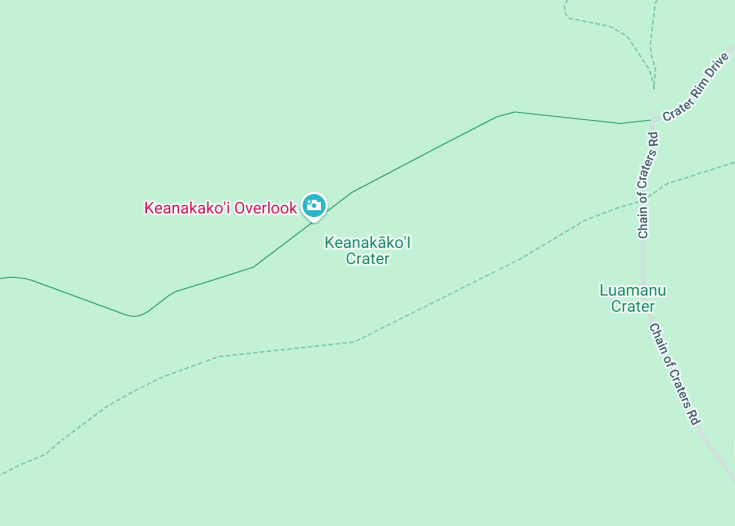Located within the enchanting expanse of Hawaii Volcanoes National Park, Keanakāko‘I Crater embodiesthe volatile beauty of nature’s craftsmanship. This geological marvel, resulting from centuries of volcanic activity, showcases dramatic features formed through explosive events and ongoing eruptions. Visitors can explore rich historical ties to Native Hawaiian culture and science, offering a profound glimpse into the natural forces shaping the Hawaiian Islands. Undoubtedly, Keanakāko‘I Crater stands as a captivating testament to Earth’s dynamic power, inviting awe and respect from those who traverse its rugged landscapes.
To best experience Keanakāko‘I Crater, arrive early in the morning to avoid crowds and capture the breathtaking sunrise over the volcanic features.
Wear sturdy hiking boots and carry sufficient water. The terrain around Keanakāko‘I Crater can be uneven and challenging, demanding proper preparation.
Keanakāko‘I crater: a gateway to Hawaii’s volcanic history
Keanakāko‘I Crater, nestled within the stunning landscapes of Hawaii’s Volcanoes National Park, offers visitors a profound glimpse into the area’s dynamic volcanic activity. This lesser-known crater, often overshadowed by its more famous neighbors, carries significant geological and cultural value. It provides a unique vantage point for observing the raw, natural beauty of Hawaiian volcanism. From the rim, tourists can gaze down into the stark, yet striking, emptiness of the crater that tells tales of its fiery past.
As part of their visit, travelers can also learn about the traditional Native Hawaiian beliefs and stories that highlight the crater’s importance in local mythology. The area around Keanakāko‘I Crater is ideal for those who cherish outdoor activities like hiking and nature photography, offering panoramic views of the surrounding volcanic landscapes that are unlike any other in the world.
Explore geological marvels at Keanakāko‘I Crater
Visitors to Keanakāko‘I Crater have an array of activities to choose from. Hiking is particularly rewarding here. The crater’s trails offer varying degrees of difficulty and provide an intimate encounter with the volcanic landscapes that shape the region. For those interested in photography, the area’s dramatic vistas provide exceptional opportunities to capture the rugged beauty of the crater and its surroundings. Along the way, informational signage helps to educate hikers about the geological processes at play and the area’s native flora and fauna. Guided tours are also available, offering insight into the site’s cultural history and its significance in local legends. Whether you’re seeking solitude or eager to learn about the natural forces that have shaped the Hawaiian Islands, Keanakāko‘I Crater is an ideal destination.
Witness the volcanic power
One of the most intriguing aspects of Keanakāko‘I Crater is its lava tube system, accessible to visitors who are eager to explore below the surface. These natural tunnels were formed by flowing lava which then hardened on the surface while still active and flowing beneath. Adventuring into these tubes allows tourists a rare peek into the inner workings of volcanic activity. The slightly eerie, yet fascinating, experience of standing where molten rock once flowed offers an unmatched perspective on the power of Earth’s geothermal forces, making it a must-see for any visit to the crater.
Explore the Wonders of Keanakāko‘I Crater
Primarily suited for outdoor enthusiasts and geology buffs, Keanakāko‘I Crater offers a spectacular view into the forces shaping our earth. Whether you’re a family looking for an educational trip or a couple seeking a unique adventure, this destination has something to intrigue every visitor. Expect a landscape that’s both majestic and educational, providing a rare glimpse into volcanic activities and geological formations.
Discover the Best Time to Visit Keanakāko‘I Crater
The ideal time to visit Keanakāko‘I Crater is during the dry seasons, from May through October, when the weather permits clearer and safer paths. The visibility is high, and the trails are mostly dry, allowing for unhindered exploration.
Annual Events Not to Miss
If you’re planning your visit, consider timing it with the Volcano Awareness Month held every January. This event features additional tours, talks, and presentations that are especially enlightening.
Accessibility and Limitations at Keanakāko‘I Crater
Understanding the accessibility and limitations before your visit can help ensure a smooth experience.
Accessibility
Limitations
- Area sometimes closed on short notice due to volcanic activity.
- Drone flying is prohibited.
- No pets allowed on the trails.
Notes to visitors
- Wear sturdy hiking shoes.
- Carry water and sun protection.
- Stay on marked trails to protect both the environment and yourself.
General Information for Your Visit to Keanakāko‘I Crater
Plan your trip with these essential details.
Location and Accessibility
Nearby significant landmarks include the famous Volcano National Park, which surrounds the crater, providing ample opportunities for extended adventure and exploration.
Address: Located within Hawai‘i Volcanoes National Park, HI.
Opening Hours
Open daily from sunrise to sunset. Note that access may vary based on volcanic activity.
Reaching Keanakāko‘I Crater
Car
Traveling by car is the most convenient way to reach Keanakāko‘I Crater, with parking available close to popular viewing areas. Here are the travel details:
| Route | Distance | Travel time |
|---|---|---|
| From Hilo | 30 miles (48 km) | 45 minutes |
| From Kona | 96 miles (154 km) | 2 hours 45 minutes |
| From Kalapana | 50 miles (80 km) | 1 hour 30 minutes |
Public Transport
Options vary, with local bus services available from major towns. Here is an idea of the journey times:
- From Hilo: Approximately 2 hours with transfers.
- From Kona: Up to 4 hours depending on connections.
Nearby Attractions
Enhance your visit by exploring these nearby attractions:
- Hawai‘i Volcanoes National Park – 0 miles (0 km)
- Jaggar Museum – 4 miles (6.4 km)
- Thurston Lava Tube – 5 miles (8 km)
- Chain of Craters Road – 8 miles (12.9 km)
- Mauna Loa Observatory – 42 miles (67.6 km)
- Punalu‘u Black Sand Beach – 47 miles (75.6 km)
- Akaka Falls State Park – 54 miles (86.9 km)
- Mauna Kea – 55 miles (88.5 km)
- Lili‘uokalani Gardens – 30 miles (48.3 km)
- Richardson Ocean Park – 32 miles (51.5 km)
- Pacific Tsunami Museum – 28 miles (45 km)
- Lava Tree State Monument – 40 miles (64.3 km)
Common Questions
What is the geological significance of Keanakāko‘i Crater?
What types of volcanic features can be observed at Keanakāko‘i Crater?
What eco-systems can be found around Keanakāko‘i Crater?
What historical events are associated with Keanakāko‘i Crater?
What safety precautions should visitors take at Keanakāko‘i Crater?
Are there any particular times of year that are best for visiting Keanakāko‘i Crater?
What are the unique flora and fauna around Keanakāko‘i Crater?
What cultural or educational programs are available at Keanakāko‘i Crater?

Is the Keanakāko‘i Crater worth visiting?
For those fascinated by volcanic landscapes and natural history, the Keanakāko‘i Crater offers a distinctive excursion. Located within the renowned Hawai’i Volcanoes National Park, the crater provides insights into the violent geological processes that shaped the beautiful Hawaiian Islands. However, potential visitors should temper their expectations regarding accessibility and visitor amenities. The area around Keanakāko‘i Crater can be somewhat remote and rugged, which might pose a challenge for those not prepared for a more adventurous experience. There are limited facilities, which means visitors should be self-sufficient and well-prepared. Despite these points, the raw beauty and the educational value of observing a volcanic crater firsthand can be quite impactful for those interested in geology and natural sciences.










